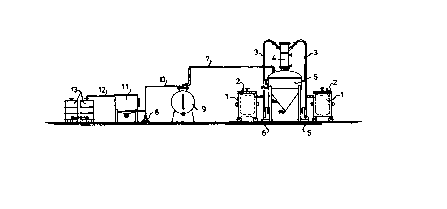Some of the information on this Web page has been provided by external sources. The Government of Canada is not responsible for the accuracy, reliability or currency of the information supplied by external sources. Users wishing to rely upon this information should consult directly with the source of the information. Content provided by external sources is not subject to official languages, privacy and accessibility requirements.
Any discrepancies in the text and image of the Claims and Abstract are due to differing posting times. Text of the Claims and Abstract are posted:
| (12) Patent Application: | (11) CA 2270104 |
|---|---|
| (54) English Title: | INSTALLATION AND METHOD FOR REMOVING MERCURY FROM WASTE MATERIALS BY VACUUM DISTILLATION |
| (54) French Title: | INSTALLATION ET PROCEDE D'ENLEVEMENT DE MERCURE A PARTIR DE DECHETS, PAR DISTILLATION SOUS VIDE |
| Status: | Deemed Abandoned and Beyond the Period of Reinstatement - Pending Response to Notice of Disregarded Communication |
| (51) International Patent Classification (IPC): |
|
|---|---|
| (72) Inventors : |
|
| (73) Owners : |
|
| (71) Applicants : |
|
| (74) Agent: | SMART & BIGGAR LP |
| (74) Associate agent: | |
| (45) Issued: | |
| (86) PCT Filing Date: | 1997-11-19 |
| (87) Open to Public Inspection: | 1998-05-28 |
| Examination requested: | 1999-04-27 |
| Availability of licence: | N/A |
| Dedicated to the Public: | N/A |
| (25) Language of filing: | English |
| Patent Cooperation Treaty (PCT): | Yes |
|---|---|
| (86) PCT Filing Number: | PCT/NL1997/000630 |
| (87) International Publication Number: | WO 1998022628 |
| (85) National Entry: | 1999-04-27 |
| (30) Application Priority Data: | ||||||
|---|---|---|---|---|---|---|
|
An installation for removing mercury from waste materials by vacuum
distillation comprises at least three electrically heatable, mobile,
hermetically sealable furnaces (1), which, in order to form a cluster, are
connected via a connecting line (3) and a cooling unit (4) to a distillation
vessel, which vessel (5) is connected to a vacuum pump (8). A standpipe (3)
with a mercury trap (6) is incorporated in each of the connecting lines
between the furnaces and the distillation vessel.
Cette installation d'enlèvement de mercure à partir de déchets, par distillation sous vide, comprend au moins trois fours mobiles, pouvant être chauffés électriquement et hermétiquement scellés (1) et qui, afin de former un groupe, sont reliés, via une canalisation de raccordement (3) et une unité de refroidissement (4), à une cuve de distillation (5), laquelle est elle-même reliée à une pompe à vide (8). On a incorporé une colonne montante (3) dotée d'un piège à mercure (6), dans chaque canalisation de raccordement entre les fours et la cuve de distillation.
Note: Claims are shown in the official language in which they were submitted.
Note: Descriptions are shown in the official language in which they were submitted.

2024-08-01:As part of the Next Generation Patents (NGP) transition, the Canadian Patents Database (CPD) now contains a more detailed Event History, which replicates the Event Log of our new back-office solution.
Please note that "Inactive:" events refers to events no longer in use in our new back-office solution.
For a clearer understanding of the status of the application/patent presented on this page, the site Disclaimer , as well as the definitions for Patent , Event History , Maintenance Fee and Payment History should be consulted.
| Description | Date |
|---|---|
| Inactive: IPC removed | 2013-02-21 |
| Inactive: IPC assigned | 2013-02-11 |
| Inactive: IPC expired | 2007-01-01 |
| Inactive: IPC removed | 2006-12-31 |
| Inactive: IPC from MCD | 2006-03-12 |
| Inactive: Dead - No reply to s.30(2) Rules requisition | 2003-10-02 |
| Application Not Reinstated by Deadline | 2003-10-02 |
| Deemed Abandoned - Failure to Respond to Maintenance Fee Notice | 2002-11-19 |
| Inactive: Abandoned - No reply to s.30(2) Rules requisition | 2002-10-02 |
| Inactive: S.30(2) Rules - Examiner requisition | 2002-04-02 |
| Inactive: Cover page published | 1999-07-19 |
| Inactive: First IPC assigned | 1999-06-14 |
| Inactive: IPC assigned | 1999-06-14 |
| Inactive: IPC assigned | 1999-06-14 |
| Inactive: IPC assigned | 1999-06-14 |
| Inactive: IPC assigned | 1999-06-14 |
| Inactive: Acknowledgment of national entry - RFE | 1999-06-03 |
| Letter Sent | 1999-06-03 |
| Application Received - PCT | 1999-05-28 |
| All Requirements for Examination Determined Compliant | 1999-04-27 |
| Request for Examination Requirements Determined Compliant | 1999-04-27 |
| Application Published (Open to Public Inspection) | 1998-05-28 |
| Abandonment Date | Reason | Reinstatement Date |
|---|---|---|
| 2002-11-19 |
The last payment was received on 2001-11-07
Note : If the full payment has not been received on or before the date indicated, a further fee may be required which may be one of the following
Please refer to the CIPO Patent Fees web page to see all current fee amounts.
| Fee Type | Anniversary Year | Due Date | Paid Date |
|---|---|---|---|
| Request for examination - small | 1999-04-27 | ||
| MF (application, 2nd anniv.) - small | 02 | 1999-11-19 | 1999-04-27 |
| Basic national fee - small | 1999-04-27 | ||
| Registration of a document | 1999-04-27 | ||
| MF (application, 3rd anniv.) - small | 03 | 2000-11-20 | 2000-11-09 |
| MF (application, 4th anniv.) - small | 04 | 2001-11-19 | 2001-11-07 |
Note: Records showing the ownership history in alphabetical order.
| Current Owners on Record |
|---|
| BEGEMANN HOLDING B.V. |
| Past Owners on Record |
|---|
| ROELAND HAVERKAMP BEGEMANN |